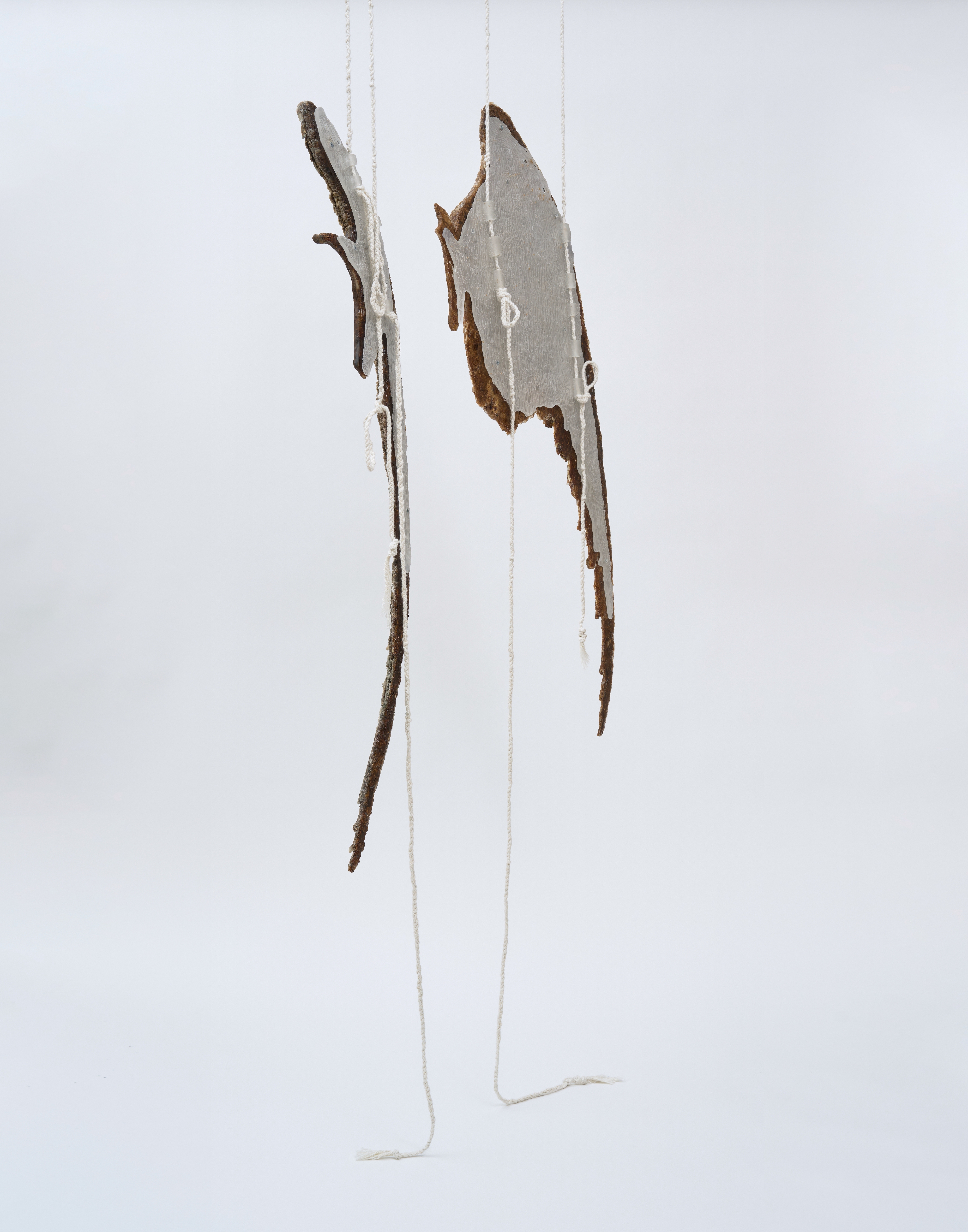
Angel
41 x 3.3 x 58.8 cm
pigment ink print, dye ink, button stud, carved acrylic
2021




The series of <Golden crutches> tells the structural limitations of the existing body by summoning the wings of the angels and Greek mythology’s Icarus and Daedalus in Western classical paintings.
Angel
The bodies of mythical beings with wings are usually described as having both a healthy human body and elegant wings. In particular, since angels in classical paintings are created by God (nature), the wings of angels appear naturally and smoothly connected to the beautiful human body. However, if an angel is an organism capable of both walking and flying, it will have a realistic structure rather than an ideal one, at least as much as the inside of its body.
The skeleton structure of an angel embodied by scientific imagination is expressed based on a technique of scratching the surface of the output after printing an image of an angel appearing in Christian painting. The ideal imagination, which has covered the body's reality like colorful clothes and shining primrose, removes it by drilling a fine needle hole, and further creates a strange feeling as if looking at the fossils of living things that actually existed. And like wings that can only fly with feathers, the finished skeletal drawing is installed narrowly upright on the floor through a feather-carved acrylic plate and clips.
<황금 목발>연작은 서구 고전주의 회화에 등장하는 날개 달린 천사와 그리스 신화의 이카루스와 다이달로스의 날개를 소환하여 현존하는 ‘몸’이 갖는 구조적 한계를 이야기한다.
<천사>
날개를 가진 신화 속 대상들의 몸은 대개 건강한 인간의 몸과 우아한 날개를 모두 가진 모습으로 묘사된다. 특히 고전 회화 속 천사는 신(자연)이 만든 존재이기에 천사의 날개는 아름다운 인간의 몸에 선천적으로 매끈하게 연결되어 등장한다. 하지만 천사가 보행과 비행이 모두 가능한 유기체 생물이라면, 적어도 그 몸의 내부만큼은 이상적이기보다는 현실적인 구조를 가질 것이다.
과학적인 상상으로 구현된 천사의 골격구조는 기독교 회화에 등장한 천사의 이미지를 출력한 뒤 출력물 표면을 긁어내는 기법을 기반으로 표현된다. 화려한 옷과 빛나는 원광처럼 몸의 실체를 가려왔던 이상적인 상상은 미세한 바늘구멍을 뚫어 제거하고, 나아가 실제로 존재했던 생물의 화석을 보는 듯한 기이함을 연출한다. 그리고 마치 깃털이 있어야만 비행할 수 있는 날개처럼, 완성된 골격구조 드로잉은 깃털을 조각한 아크릴판과 집게를 통해 바닥에 아슬아슬하게 직립되어 설치된다.
- The painting where the angel came from.

The Annunciation, Francesco di Stefano Pesellino, 1451

* With new <Golden Crutches> at 2025.
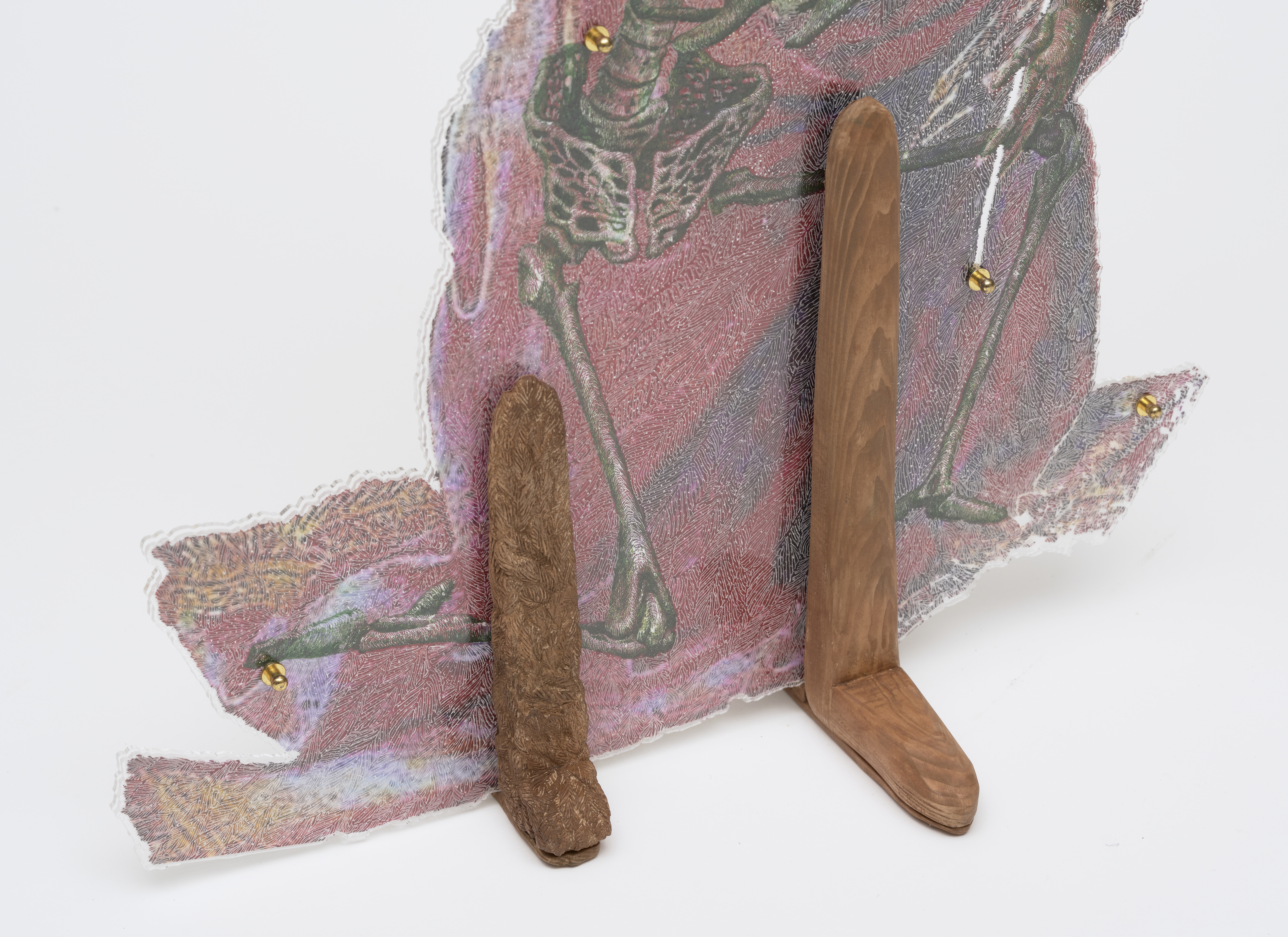
Golden Crutches
carved and oil stained wood, leather, screws
each 2.8 x 8.8 x 15.8 cm, 2.8 x 18 x 22.4cm
2025

Daedalus
44 x 55 x 2 cm
pigment ink print, beeswax, thread, wood, metal
2021
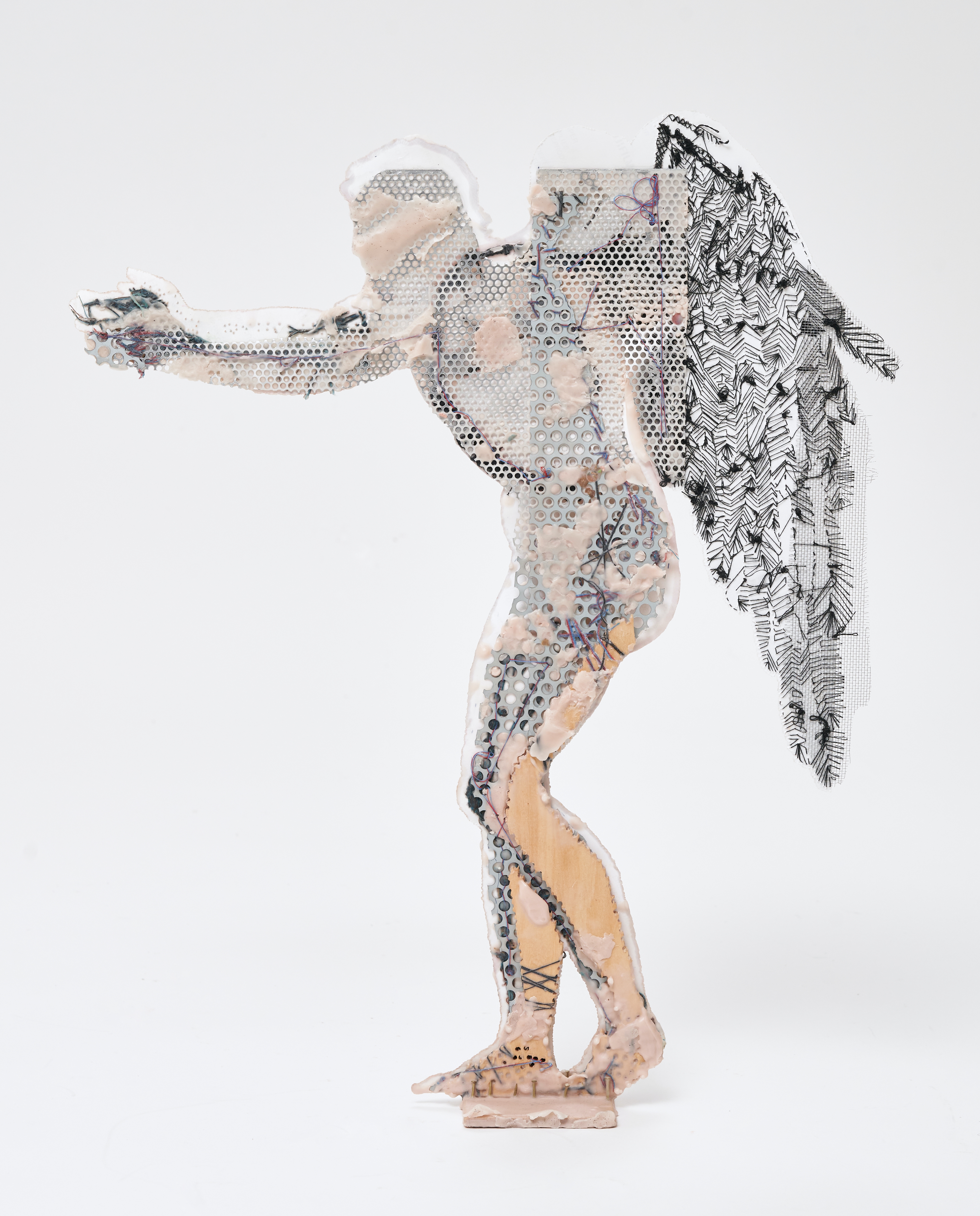


<Daedalus> is one of the works in the <Golden Crutches> series, in which the artist summons the bodies of winged creatures from Western classical paintings to reconstruct their smoothly rendered bodies in a realistic way.
Mythological winged figures are usually depicted as having both a healthy human body and graceful wings. However, for Icarus and Daedalus in Greek mythology, wings are an acquired 'prosthetic' that allows them to transcend their physical limitations. So if we want to be realistic about the myth of their flying with wings, they would at least have to go through a rough and painful surgical process, removing parts of the body that allow them to walk and adding auxiliary bones and muscles to make the wings work.
<다이달로스>는 <황금 목발> 시리즈 작업 중 하나로, 서구 고전주의 회화에 등장하는 날개를 가진 존재들의 몸을 소환하여 매끄럽게 이미지화된 몸을 현실적으로 재구성을 하고자 한다.
날개를 가진 신화 속 인물들의 몸은 대개 건강한 인간의 몸과 우아한 날개를 모두 가진 이미지로 묘사된다. 그런데 그리스 신화에 등장하는 이카루스와 다이달로스에게 날개란 인간의 신체적 한계를 뛰어넘기 위해 후천적으로 부착한 ‘보철 장치’에 해당한다. 그러므로 그들이 날개를 몸에 부착해 비행한 신화를 현실적으로 접근하자면, 적어도 보행을 위한 신체 부위가 제거되고 날개를 작동시키기 위한 보조 골격과 근육을 덧붙이는 거칠고 고통스러운 외과적 과정을 통과해야만 한다. 마치 황금으로 만들어진 목발처럼, 이들의 날개는 곧 날 수 없는 몸을 위한 우아한 보조 장치임과 동시에 불안정하고 매끄럽지 못한 신체 상태를 드러내는 장치가 된다.
- The painting where the Daedalus came from.

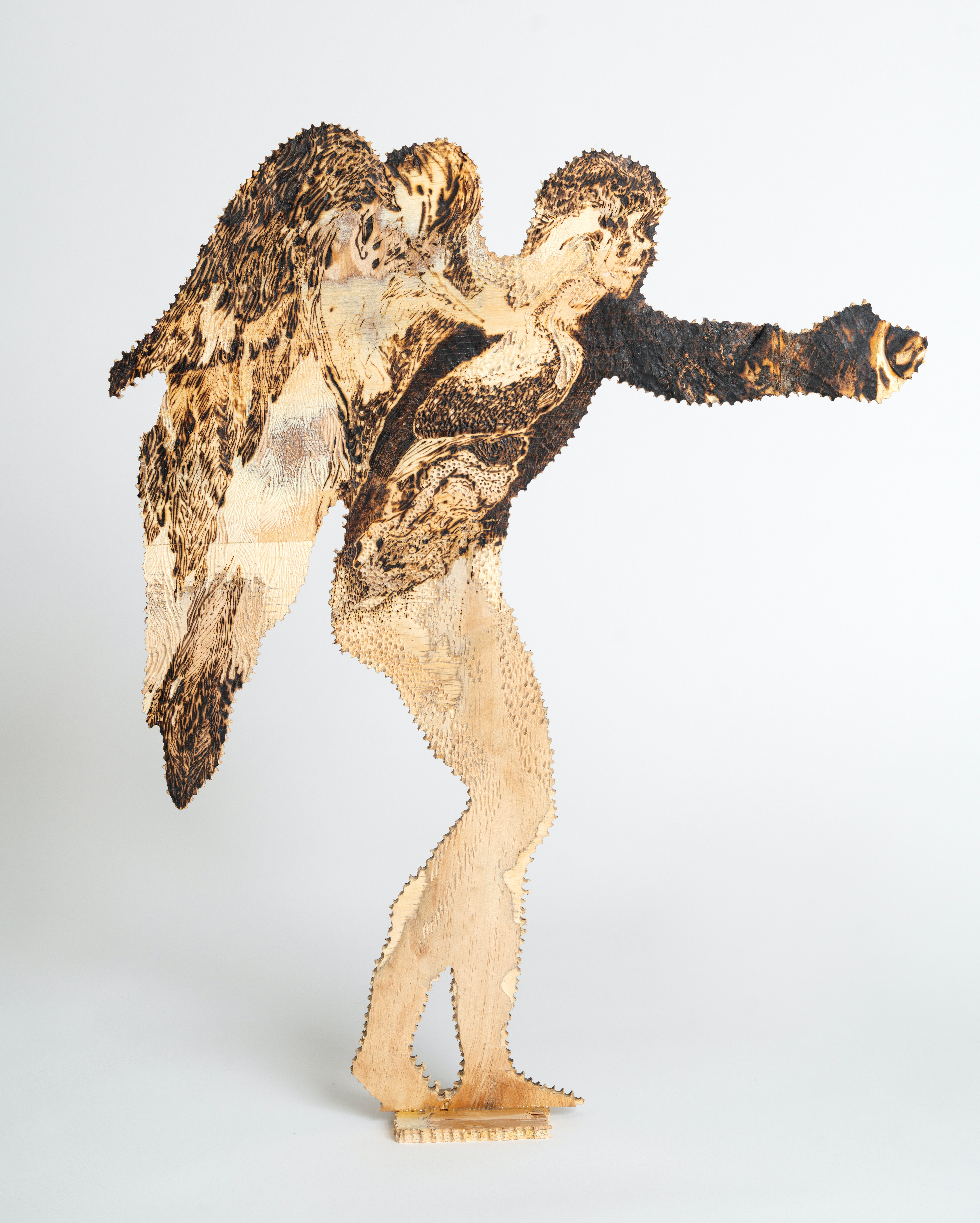
Daedalus
42.8 x 8 x 53.2 cm
drawing with soldering iron and carving machine on ply wood
2025

Calvárīa archangeli Gabrieli (Angelos Gabriel Cranium)
32 x 32 x 1cm
carved pigment ink print, beeswax
2021
<Calvárīa archangeli Gabrieli> is a skeletal structure drawing that was made in a similar size to a skeleton by printing the face of an angel in another classical painting in the process of producing <Angel> in a series of <Golden crutches> similar to a human body size. At this time, the scientific name of the method was used to look closely at the living organism species of angels, such as "genus" and "species" of Gabriel. And to look close to the stuffed biological specimen, wax was added to the floor in an upright form.
<천사속 가브리엘종의 머리뼈>
<황금 목발>연작의 <천사>를 인간의 신체 크기와 유사하게 제작하기 위한 과정에서 또 다른 고전 회화 속 천사의 얼굴 부위를 출력해 해골과 유사한 크기로 제작한 골격구조 드로잉이다. 이때 천사를 실존하는 유기체 생물종에 가깝게 바라보기 위해 천사’속’ 가브리엘 ‘종’이라는 이명법의 학명을 사용했다. 그리고 박제된 생물 표본에 가깝게 바라보기 위해 바닥에 직립할 수 있는 형태로 밀랍을 덧입혔다.
- The painting where the angel came from.
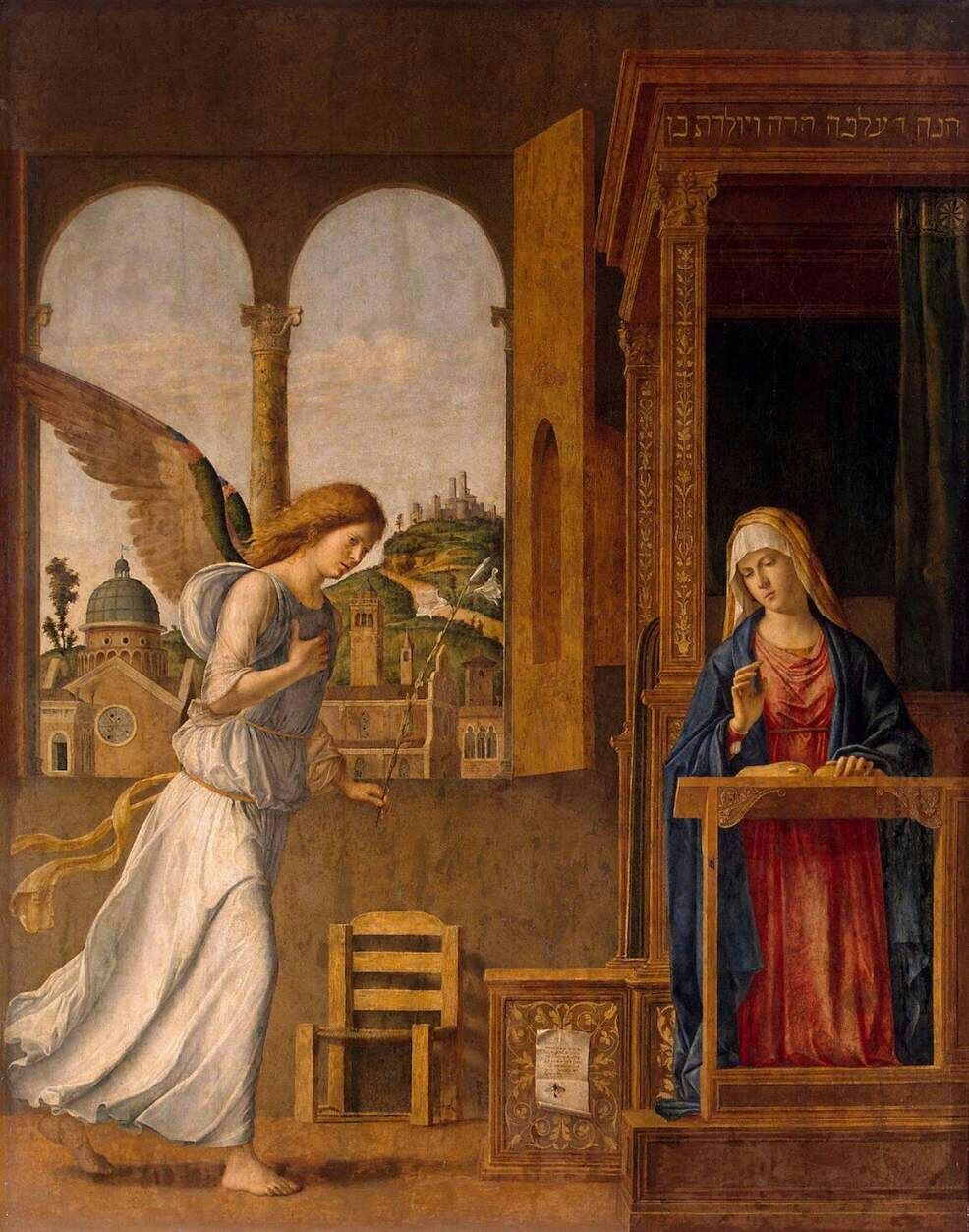
The Annunciation, Cima da Conegliano, 1495

Naturally Occurred Species
under 21 x 29.7 x 4 cm each
pigment ink print, dye ink, thread, crystalized potassium aluminum sulfate
2022
<Naturally Occurred Species> is the result of a study to put <Angel> on the floor of <Golden crutches> series. In the first esquisse, the acrylic plate and clips were upright on the floor through a detachable prosthetic device, but the angel's body was judged to be inconsistent with the view that it was an innate spontaneous species, so the material study began. As a material that can form a sense of unity with the drawing of output and is far from non-natural artificial synthetic materials, the experiment was conducted by first selecting "crystallization," which is a supersaturated state of minerals. After sewing the thread on the back of the drawing, it succeeded in identifying the conditions for upright drawing of the output by generating white crystals. After that, it will further experiment with frankincense, resin, and mushroom mycelium.
<자연발생종>
<황금 목발>연작의 <천사>를 바닥에 직립시키기 위한 연구의 결과물이다. 첫 번째 에스키스에서는 아크릴판과 집게라는 탈부착 보철 장치를 통해 바닥에 직립 시켰지만, 천사의 몸이 선천적인 자연발생종이라는 관점과 일치하지 않는다고 판단해서 재료 연구를 시작했다. 출력물 드로잉과 일체감을 형성할 수 있고, 비자연적인 인공 합성 물질과 거리가 먼 재료로서 우선 광물질의 과포화 상태인 ‘결정화’를 선택해 실험했다. 그리고 드로잉 뒷면에 실을 바느질한 뒤 백반 결정을 생성시켜 출력물 드로잉을 직립시킬 수 있는 조건을 파악하는데 성공했다. 이후에는 유향, 송진, 버섯균사체 등을 추가 실험하고자 한다.
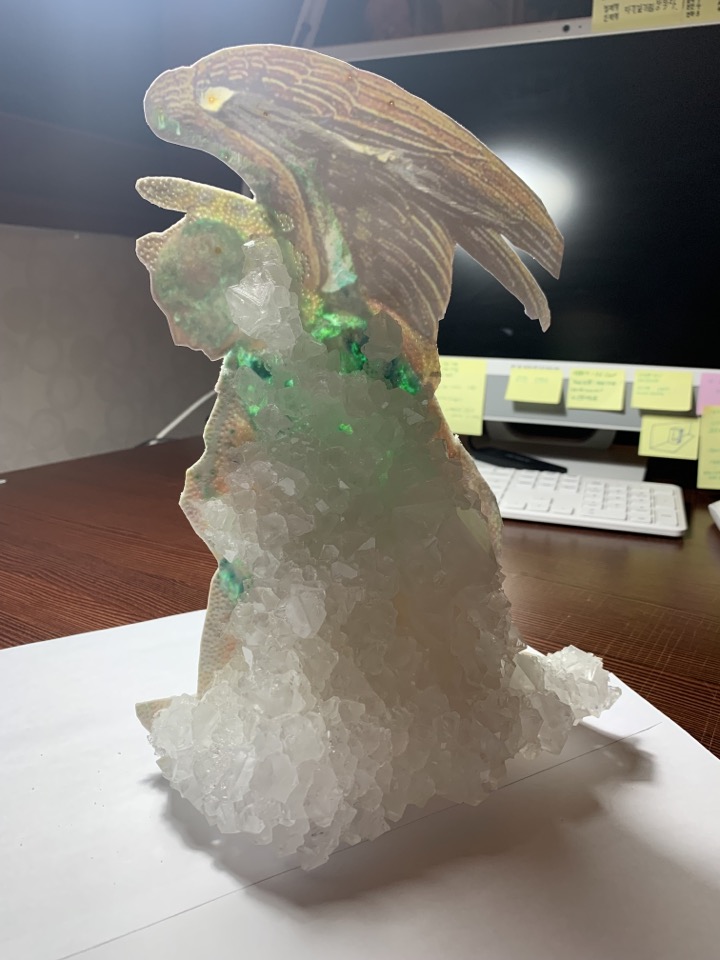
- Progress photo of <Naturally Occurred Species>
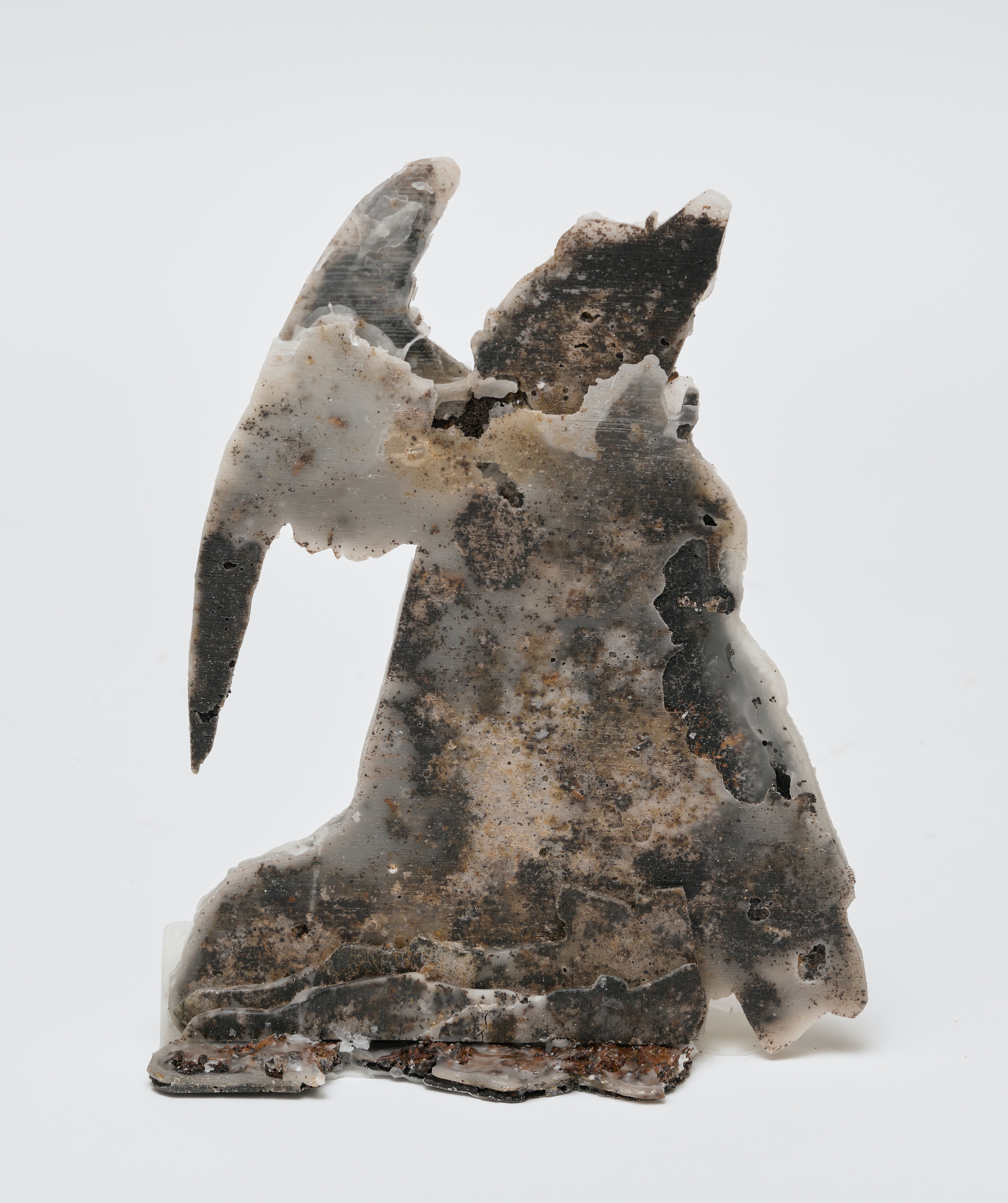
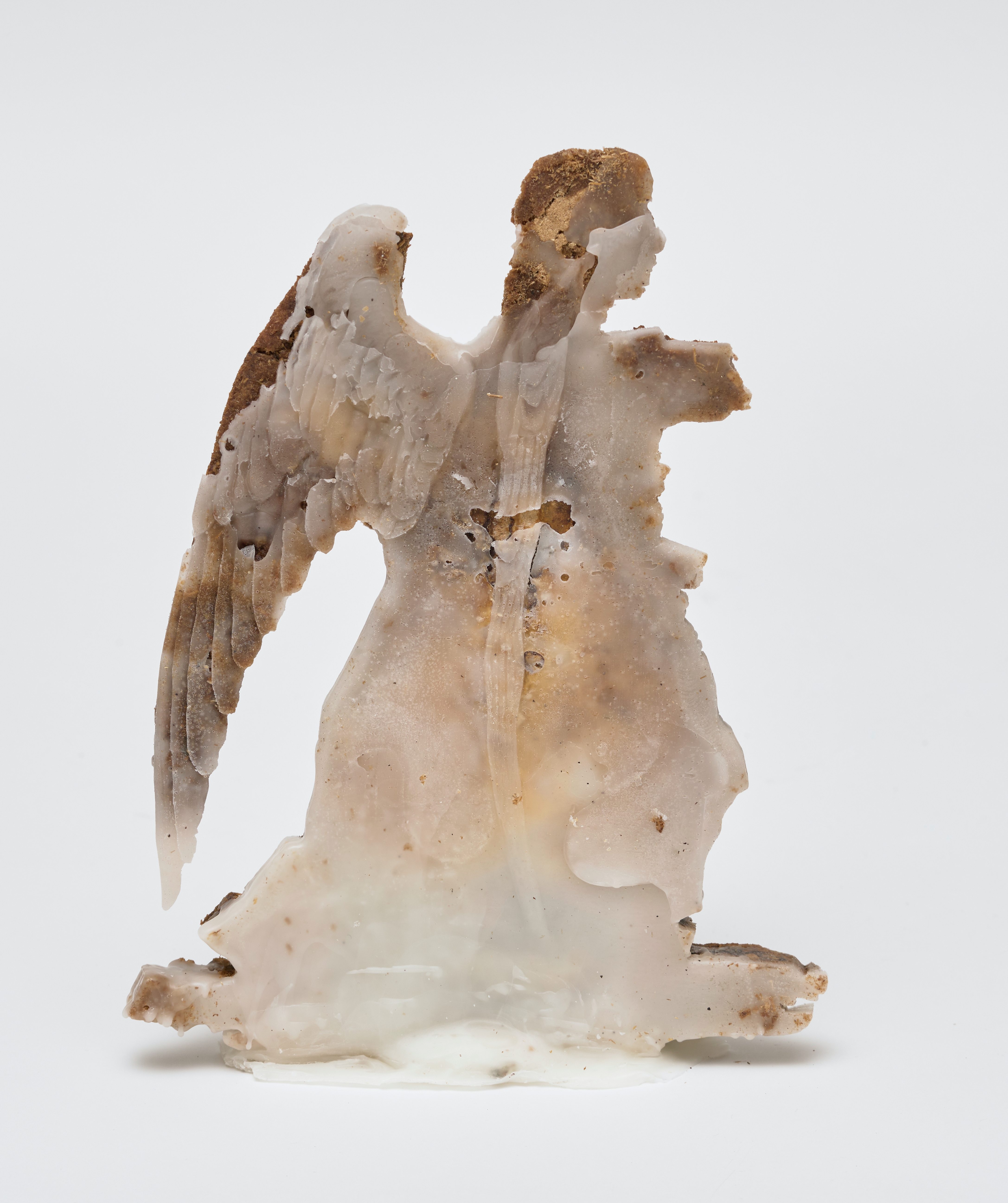
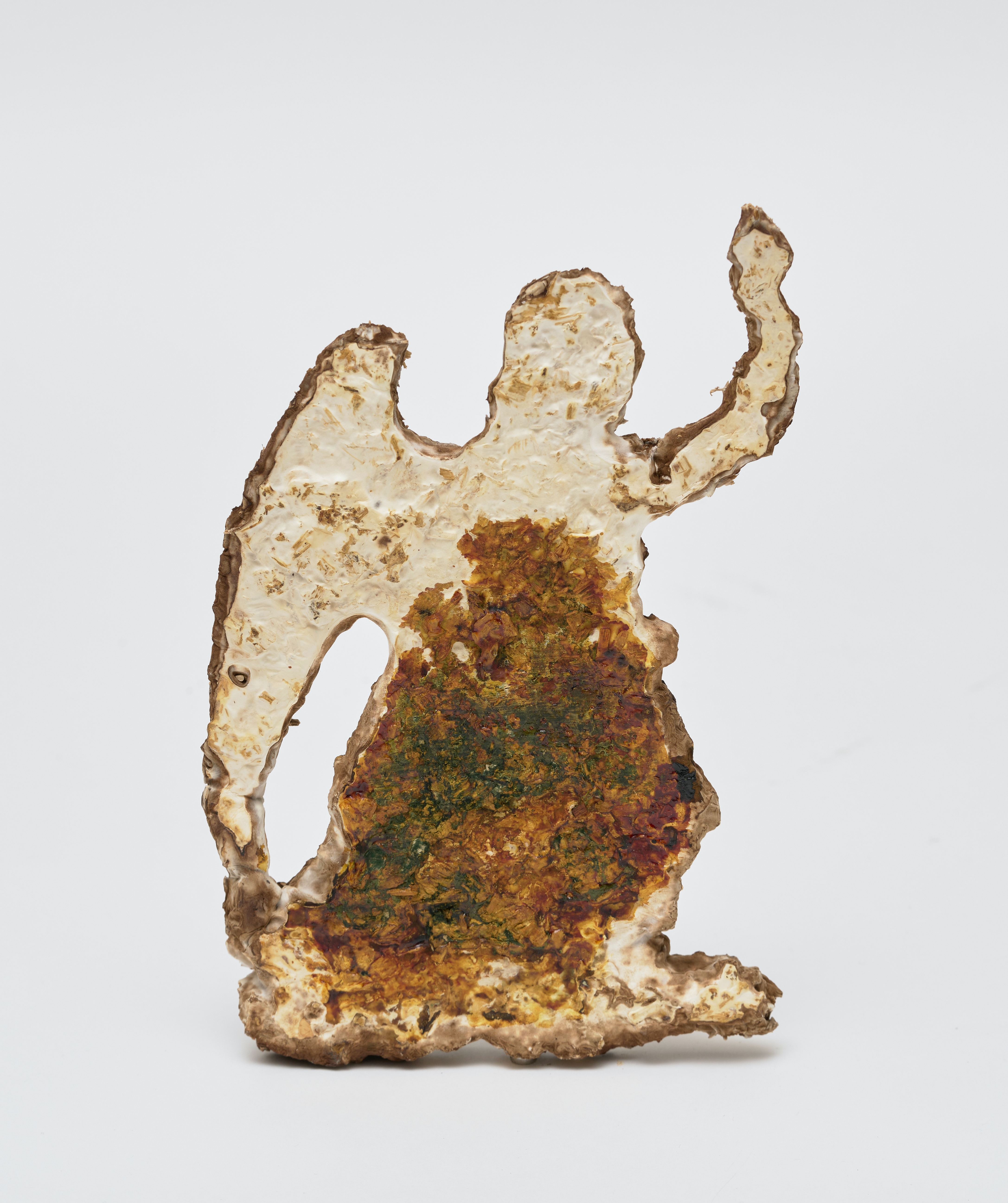
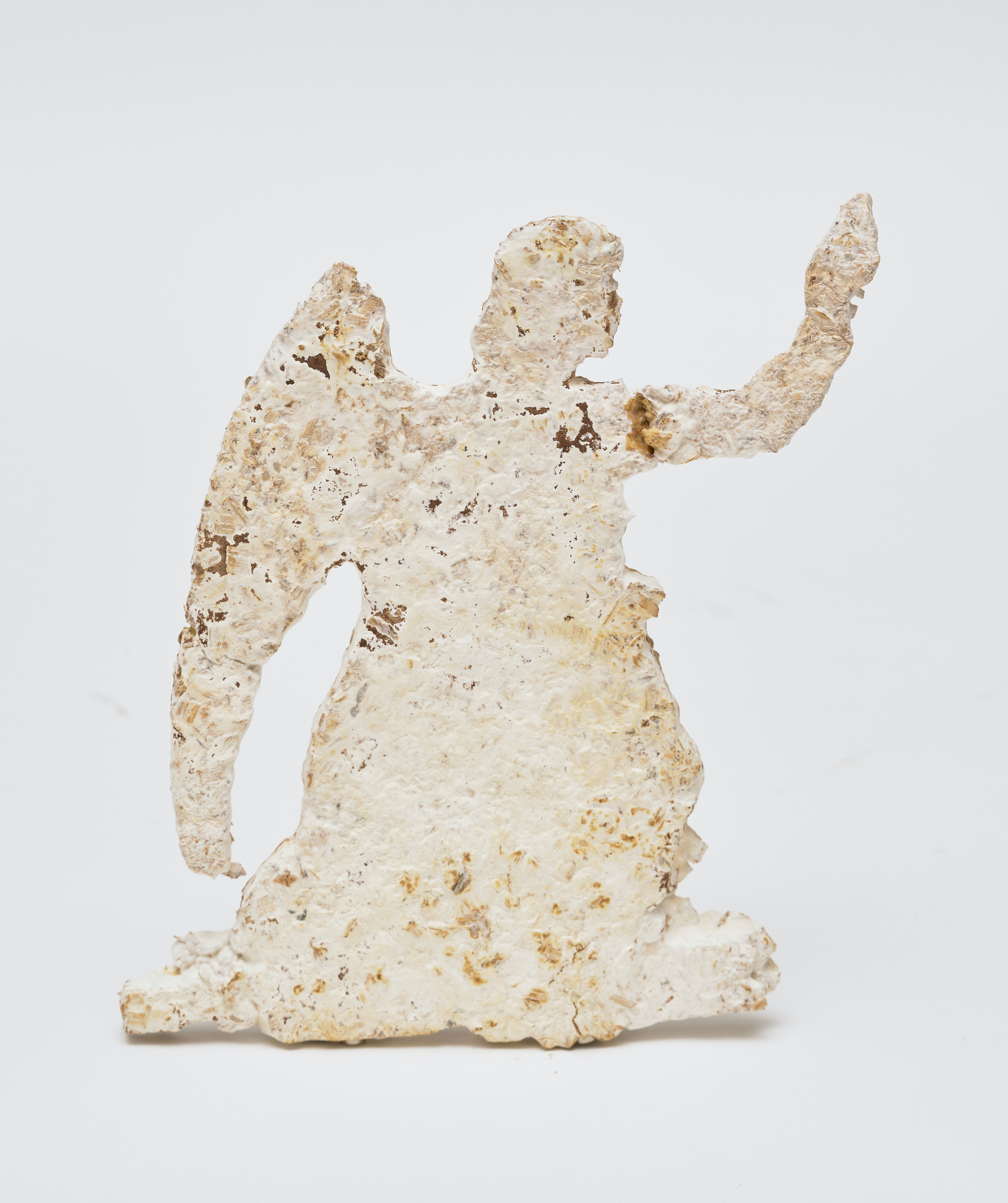
Naturally Occurred Species
under 20.5 x 4.5 x 25.5 cm each
mycelia of fungus, Povidone-iodine , beeswax, epoxy, screws, magnets
2025
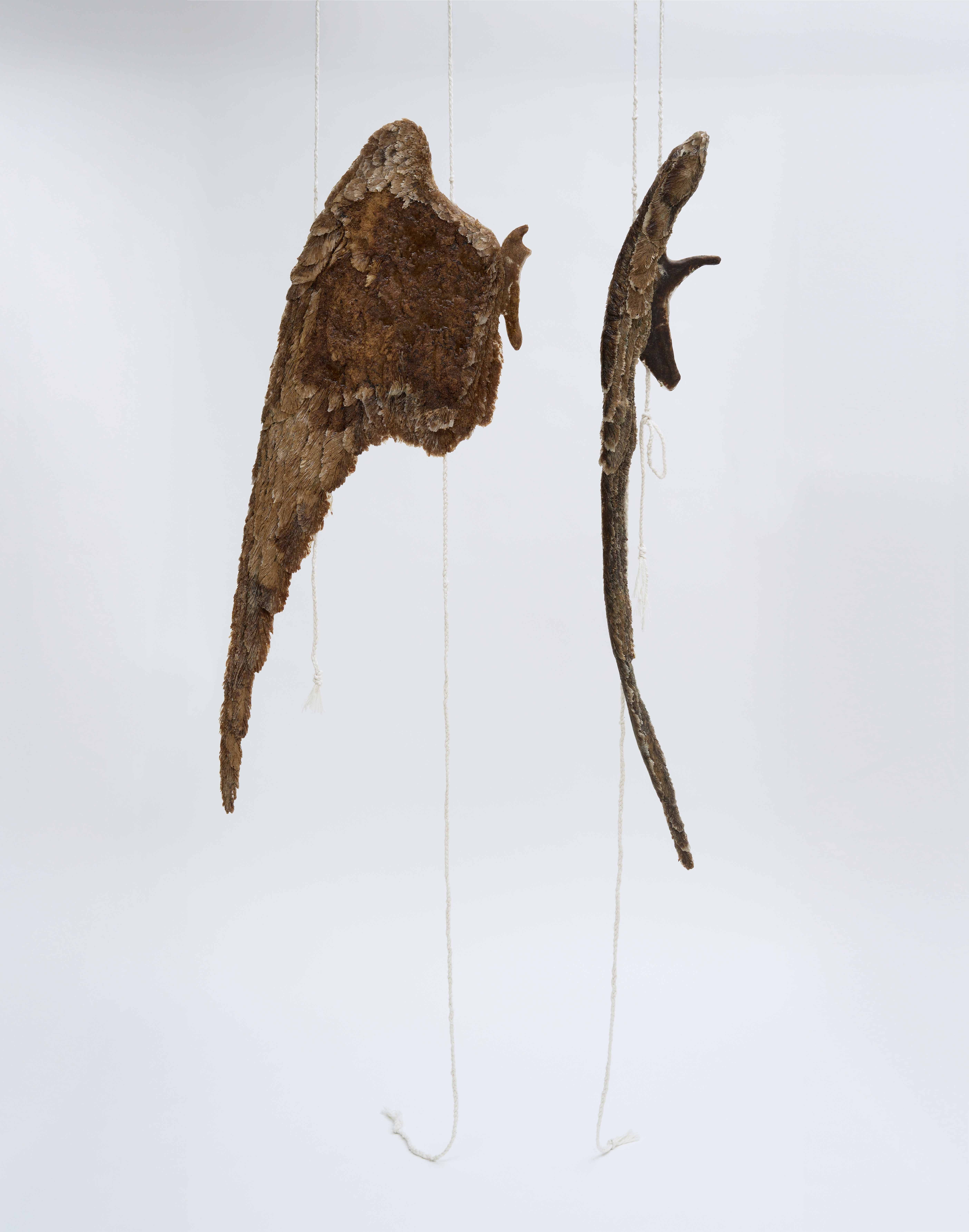
Naturally Occurred Species
(L) 53.2 x 104 x 3.5 cm (R) 16.7 x 112.3 x 4 cm
mycelia of fungus, Povidone-iodine, epoxy
2025
